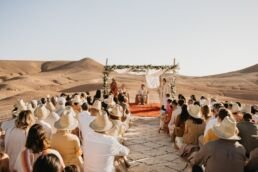Multicultural Weddings:One Day Might Not Be Enough, And That’s Okay
Blending two cultures in a wedding is a beautiful journey, one filled with meaning, symbolism, and stories passed down through generations. Whether you’re honoring different languages, customs, religions, or family traditions, trying to fit everything into a single day can feel overwhelming, and sometimes, even impossible.
That’s why many multicultural couples are choosing to stretch the celebration across multiple days. A multiday wedding offers space, not just in terms of time, but emotional space, too. Space to slow down. To celebrate each culture individually. To allow your families and guests to connect and understand each other more deeply. And of course, to truly enjoy every moment without rushing.
But let’s be honest: a multiday wedding also comes with more planning, bigger logistics, and sometimes a bit of stress. It’s not the right choice for everyone, and that’s completely okay.
So how do you know if it’s right for you?
In this article, we’ll explore the pros and cons of planning a multiday multicultural wedding, including real-life insights from couples who’ve been there. You’ll find honest reflections, thoughtful solutions to common challenges, and tips to help you decide what feels most meaningful and manageable for your celebration. Because ultimately, your wedding should feel like you, not a checklist, not a compromise, but a joyful reflection of your story.
Pros of a Multiday Multicultural Wedding
1. Each Culture Gets Its Moment
One of the biggest benefits of a multiday wedding is that each culture can truly shine. Instead of cramming two (or more!) rich traditions into a single day, you can give each its own dedicated space, and the emotional weight it deserves.
Trying to do a Hindu ceremony in the morning and a Western wedding in the evening might work logistically, but it can often feel rushed, chaotic, or emotionally overwhelming. Important rituals may get shortened. Outfit changes can feel like a backstage scramble. And meaningful moments may blur together before you’ve had time to soak them in.
A multiday approach lets you breathe. It gives both you and your guests time to immerse themselves in the experience, from understanding the significance of a ritual to dancing freely without thinking about what’s coming next.

Even if you don’t go full three days, dedicating a day to each culture – or splitting ceremonies across two weekends – can create a balanced, more intentional experience. It shows respect for both sides and helps each family feel seen, heard, and celebrated.
And remember: it’s not about doing more, it’s about making room for meaning.

2. It Feels More Relaxed
Let’s be real, weddings are joyful, but they can also be a lot. Between early starts, outfit changes, emotional moments, and trying to spend time with every guest, one single day can fly by in a blur. You might barely have time to eat, let alone take it all in.
Stretching the celebration over multiple days gives you, and your guests, the gift of breathing room. You get time to rest, reset, and actually enjoy each moment rather than rushing from one to the next.
Guests appreciate it, too. With a multiday wedding, you can spread out events: maybe a welcome dinner where people connect casually, a cultural ceremony the next day, and a relaxed reception or farewell brunch after that. It feels like a joyful mini-festival, rather than a marathon.
“One day felt like too much, but two days feels natural, especially with Indian traditions in the mix. We get to celebrate properly and spend time with the people we love.”
Bonus: A more relaxed pace can lead to more authentic memories, conversations that aren’t rushed, moments you actually remember, and space for spontaneous joy.
Tip: Worried about planning multiple days? A good wedding planner (especially one with multicultural experience) can help smooth the logistics so you can focus on celebrating.
3. You Can Invite People to What Feels Right
One of the best things about a multiday wedding? Flexibility. Not every guest will be able to attend every event, and that’s okay. With a multiday format, you can design your celebration in layers: some moments big and festive, others smaller and more intimate.
Maybe you host a larger reception for extended family and friends, but keep the ceremony day more private. Or perhaps one day is culturally specific and the other is more universal, so guests can choose what resonates most with them.
“We held our events months apart, which meant some people who couldn’t make it to Event A still came to Event B. It gave us two chances to celebrate with our favorite people.”
This setup can also ease financial and logistical pressure for your guests. They’ll appreciate the ability to choose what works for their schedules, energy levels, and budgets, especially if they’re traveling.
Tip: Be thoughtful in your communication. Let guests know they’re welcome even if they can only attend one event, and explain what each part of the celebration means to you. This sets the tone and removes any awkwardness or pressure.

4. Guests Connect More Deeply
One of the most beautiful aspects of a multiday multicultural wedding is how it brings people together, not just for your love story, but across cultures, generations, and languages.
Spending a few days in celebration allows your guests to move beyond surface-level greetings. Whether it’s a welcome dinner, a traditional pre-wedding ritual, or a relaxed brunch the next day, these shared experiences spark real conversations and lasting bonds.
It’s not just a wedding, it’s a cultural exchange. Guests begin to understand each other’s customs, food, music, and humor. They might learn to tie a sari, try a new dance, or participate in a ceremony they’d never experienced before. These moments create connection and mutual respect in a way that one fast-paced day rarely allows.
“Our welcome party helped break the ice, by the time the wedding day came, everyone was hugging like old friends. It felt like both families really got each other.”
Tip: Include light, informal events that encourage mingling, like a cultural food night, a group excursion, or even a dress code that introduces people to the other side’s traditional wear. These shared moments create the kind of community feeling that lingers long after the last dance.
5. It’s Familiar for Some Cultures
ctually feel too short or rushed.
“Indians are used to multiday weddings. I just checked in with my Filipino side to make sure they’d be comfortable too.”
That said, it’s always worth considering how your guests from other backgrounds might feel. If they’re unfamiliar with multiday events, they might worry about taking too much time off or not knowing what to expect. Clear communication and thoughtful planning can help ease those concerns.
Tip: Share a simple wedding weekend schedule ahead of time and include short explanations of cultural events in your invitations or wedding website. Let guests know which events are optional or more intimate, and be clear about what to wear or bring, this helps everyone feel included and informed, no matter their background.
Cons of a Multiday Multicultural Wedding but How to Make It Work
1. It’s More Planning : But You Don’t Have to Do It Alone
It’s no secret, planning a multiday wedding comes with its challenges. With multiple events to coordinate, you’ll need to manage additional logistics, vendors, timelines, and the expectations of family members from different cultural backgrounds. But don’t worry, more days doesn’t have to mean more stress for you.
Solution: Hire a wedding planner, preferably one with experience in multicultural or destination weddings. An experienced planner will help you juggle the complexities of blending different traditions, keep everything running smoothly, and ensure your schedule is manageable for you and your guests. They’ll also help liaise with vendors across multiple days, so you don’t have to worry about last-minute details.

Tip: If your budget is tight, consider hiring a partial planner or a day-of coordinator. Even having someone take charge of the final details will relieve a lot of pressure and ensure your day unfolds as smoothly as possible. It’s an investment that will allow you to focus on the fun and meaningful parts of the celebration, instead of being buried in logistics.
Remember, the more support you have, the more you can actually enjoy the experience, and that’s what matters most!
2. Guests Might Not Attend Everything, just Give Them Flexibility
Not every guest will have the time, budget, or energy to attend every event, especially if they’re traveling long distances. With a multiday celebration, you may have guests who can only attend one part of the wedding, which is perfectly okay, the goal is to make everyone feel included, even if they can’t be there for every moment.
Solution: Create a clear schedule of events that includes optional activities. Let guests know which events are “must-attends” and which are more flexible, and be transparent about what each event entails. You can even designate one day as the “main event” to set expectations. This way, everyone knows where to focus their attention and won’t feel pressured to attend every single moment.
Tip: Consider livestreaming one of your ceremonies, or create highlight videos or recap content for guests who can’t attend both events. This allows everyone to feel like they’re part of the celebration, even if they couldn’t make it in person. You could also send out a few “thank you” notes or digital updates with photos from the events they missed to keep them in the loop.
Ultimately, flexibility ensures that your guests can join you in the way that works best for them, without feeling overwhelmed by the logistics of attending everything.

3. Family Expectations Multiply, But It’s a Chance for Collaboration
When you extend your wedding celebration over multiple days, it can bring an influx of opinions and sometimes increased pressure to ensure both cultures are represented perfectly. Family members may have strong feelings about how certain traditions should be carried out, and balancing both sides’ expectations can feel like a delicate dance.
Solution: Start by having open, honest conversations with your families early in the planning process. Ask what traditions are most important to each side and listen to their concerns and desires. Then, look for ways to creatively honor these traditions without overwhelming the schedule. This is also a great opportunity to invite family members to take an active role in the planning, whether that means having your father-in-law lead a portion of the ceremony, or asking your mom to help choose a traditional dish for the reception. Sharing responsibilities can help reduce stress and make everyone feel more involved in the celebration.
Tip: It’s okay to say no to some requests. While it’s natural to want to please everyone, remember that your wedding day (or days!) is about honoring you and your partner’s unique love story. Focus on the traditions that truly matter to you both and that reflect the essence of who you are, rather than feeling obligated to include everything that’s expected. Keeping the celebration meaningful and balanced will make it a much more joyful experience for everyone involved.
By collaborating with your families and setting clear boundaries around what feels right for you, you can navigate multiple cultural expectations with love, respect, and grace.
4. It Can Be Costly, But There Are Smart Ways to Save
More days usually mean more food, outfits, decor, and accommodations, which can. A multiday wedding can quickly become an investment, with additional costs for food, outfits, decor, and accommodations. But, with a little planning, you can keep it high-end without overspending, ensuring that every part of the celebration feels special without breaking the bank.
Solution: Be strategic with your choices to maintain an elevated experience across multiple days. Consider selecting one venue that can accommodate different parts of the celebration, this reduces transportation costs and helps streamline logistics while maintaining a sense of continuity. You could also reuse key decor elements, like florals, but refresh them to create different vibes for each event. For example, use the same floral arrangements for your welcome dinner and ceremony but swap out elements for the reception to create a fresh look.
Another smart tip is to look for suppliers who offer package deals for multiday events. Some caterers, photographers, or event planners offer packages that cover multiple days, often at a more reasonable rate than booking them separately.
Tip: Focus your spending on the moments that matter most to you and your guests. Rather than splurging on every element, make sure key moments – like the ceremony, special meals, or performances – get the attention they deserve. Quality over quantity is key: invest in good food, well-curated decor, and memorable experiences. Small touches, like personalized favors or thoughtful entertainment, can elevate the experience without requiring a massive budget.
By carefully considering where to allocate your budget, you can create a meaningful and high-end multiday wedding experience that feels refined but not overly indulgent, ensuring your celebration is memorable without stretching your finances.

5. Balancing the Fusion Can Be Tricky, But That’s What Makes It Special
Blending two distinct cultural or religious traditions into a single ceremony can be challenging. If not done thoughtfully, it might feel forced or inauthentic. However, when done with care and respect, it can be an incredibly meaningful way to honor both sides of your heritage.
Solution: The key to a successful fusion ceremony is collaboration. Work closely with an officiant or celebrant who specializes in fusion or interfaith ceremonies. They can guide you through the process of combining elements in a way that feels natural and balanced. A skilled celebrant will not only respect each tradition but will also be able to help you create a ceremony that authentically represents both cultures without overshadowing either one. This may include weaving together different rituals, symbols, or readings that are meaningful to both families, ensuring that each side feels seen and valued.
Tip: If the fusion idea feels like too much to manage, don’t be afraid to keep things simple by dedicating a day to each culture. Sometimes, it’s better to allow each tradition to shine individually rather than forcing them to coexist in one ceremony. Separating the cultural celebrations can actually enhance the beauty of each one and give both traditions the space they deserve. This way, each side can feel fully immersed in their own customs without compromise.
Remember, a wedding is about celebrating your union and the unique love story you share. Whether through fusion or separate celebrations, what matters most is honoring both cultures in a way that feels authentic to you as a couple.
Tips to Make It Work
- Talk to your families early. Explain your vision, ask about what traditions matter most, and find areas for compromise.
- Know your guests. Think about who’s likely to attend each event, and how familiar they are with multi-day formats.
- Communicate clearly. Send detailed invitations or websites explaining the schedule, dress codes, and what to expect.
- Choose a venue that allows multi-day rentals. This simplifies setup, décor, and keeps the vibe consistent.
- Make space for rest. Don’t overfill your schedule.
- Leave time for connection, quiet moments, and breathers.
So… Is a Multiday Wedding Right for You?
Only you know what feels right, but if you’re trying to celebrate two cultures, give both families space to feel seen, and create something truly meaningful (not just efficient), then yes, a multiday multicultural wedding might be your best decision yet.
You don’t have to do everything over two days. You just need to do what matters most to you: with heart, with joy, and with intention.
You need help capturing a wedding that honors your roots and your story? Let’s talk, I specialize in multicultural celebrations that blend tradition with ease, in sunny, soulful destinations around the world.
Let's create memories that don’t just remind you of how your wedding looked, but how it felt.
I'll take care of you and your project
Let's craft your dream day following those guided steps
01
Reach out through my inquiry form
Don’t stress if you don’t have every detail figured out yet! Many couples who contact me are still in the early stages of planning, and that’s perfectly fine!
02
Let’s schedule a complimentary consultation
During our call, we’ll connect and chat about your vision for the day.This is where I get to know your story, what matters most to you, and how you imagine your celebration. I’ll share how I work, offer helpful insights, and answer all your questions.
03
Now we can bring your vision to life!
Once you're ready, we’ll make it official with a signed contract and retainer. From there, I’ll guide you every step of the way, from prepping for your photos to give you tips and advices, so you feel fully supported and excited for what’s ahead.
Ready to Plan Your Intimate Wedding?
Fill out the inquiry form, and we’ll schedule a consultation to discuss your wedding vision and begin planning your perfect day.
More Resources for your Wedding
Everything you want to know – I’m happy to share some free ressources to help you




